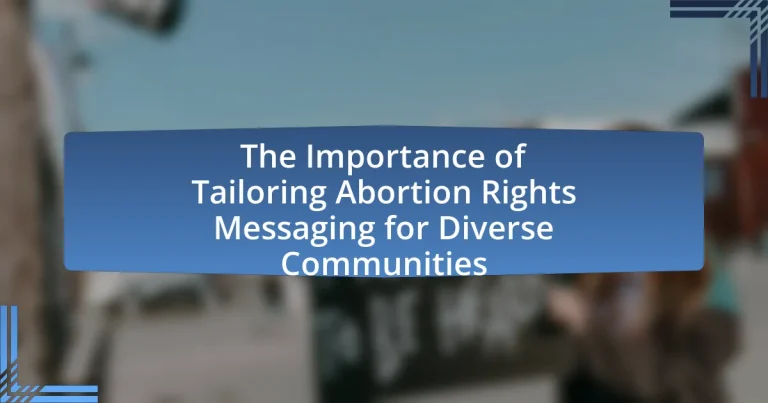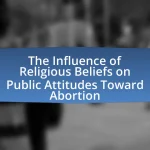The article emphasizes the critical importance of tailoring abortion rights messaging to effectively engage diverse communities. It highlights how cultural, social, and economic contexts shape perceptions of reproductive health, necessitating customized communication strategies that resonate with specific audiences. Key discussions include the influence of cultural beliefs on abortion perceptions, the consequences of a one-size-fits-all approach, and the role of community involvement in shaping effective messaging. Additionally, the article outlines best practices for organizations to enhance their outreach efforts, including the use of culturally relevant language and imagery, and the importance of partnerships with local organizations to foster trust and credibility.
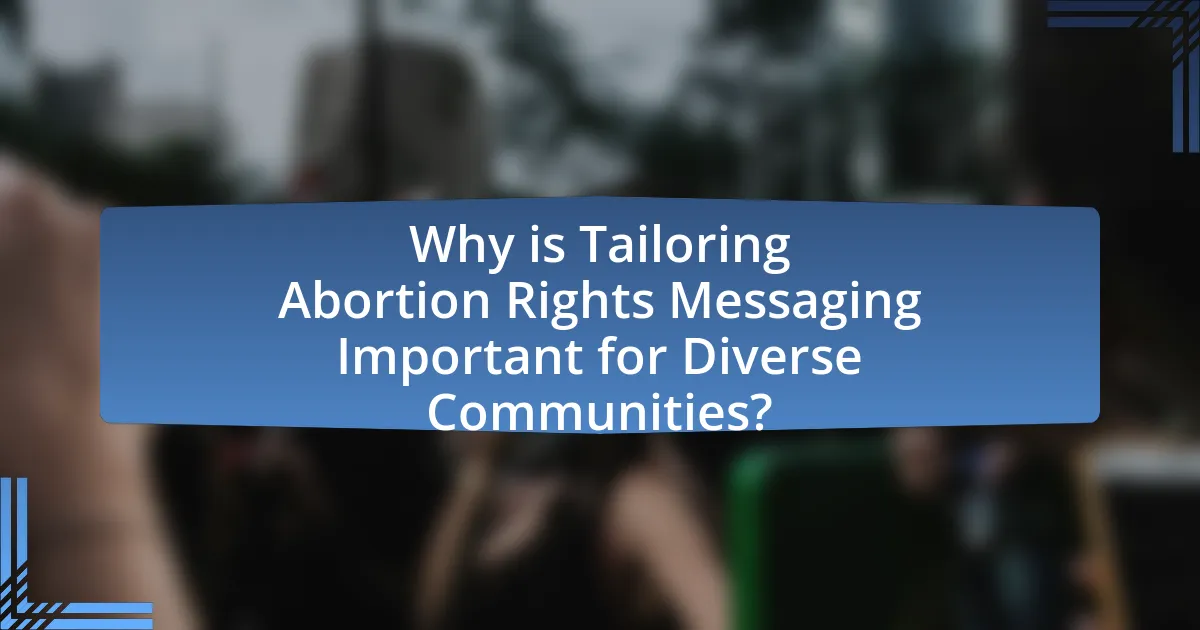
Why is Tailoring Abortion Rights Messaging Important for Diverse Communities?
Tailoring abortion rights messaging is crucial for diverse communities because it ensures that the unique cultural, social, and economic contexts of these groups are acknowledged and addressed. Effective communication that resonates with specific communities can lead to increased awareness and understanding of reproductive rights, ultimately empowering individuals to make informed decisions. For instance, research from the Guttmacher Institute indicates that marginalized populations often face barriers to accessing reproductive health services, highlighting the need for targeted messaging that speaks directly to their experiences and concerns. By customizing the approach, advocates can foster trust and engagement, leading to more effective advocacy and support for abortion rights within these communities.
How does cultural context influence abortion rights messaging?
Cultural context significantly influences abortion rights messaging by shaping the values, beliefs, and attitudes of different communities toward reproductive health. For instance, in societies where religious beliefs strongly oppose abortion, messaging often emphasizes moral and ethical considerations, framing abortion as a violation of sacred values. Conversely, in more secular or progressive cultures, messaging may focus on women’s rights, bodily autonomy, and public health benefits, advocating for access to safe and legal abortion services. Research indicates that tailored messaging that resonates with specific cultural narratives can enhance engagement and support; for example, a study by the Guttmacher Institute found that culturally relevant communication strategies increased awareness and acceptance of reproductive rights among diverse populations.
What role do cultural beliefs play in shaping perceptions of abortion?
Cultural beliefs significantly influence perceptions of abortion by framing moral, ethical, and social contexts surrounding the issue. For instance, in many religious communities, beliefs about the sanctity of life can lead to strong opposition to abortion, viewing it as morally unacceptable. Conversely, cultures that prioritize individual autonomy may support abortion rights, emphasizing personal choice and bodily autonomy. Research indicates that these cultural frameworks shape public opinion and policy, as seen in varying abortion laws across countries, where nations with conservative cultural beliefs often impose stricter regulations compared to those with more liberal views. This demonstrates that cultural beliefs are pivotal in determining how abortion is perceived and legislated within different societies.
How can understanding cultural context improve messaging effectiveness?
Understanding cultural context enhances messaging effectiveness by ensuring that communication resonates with the values, beliefs, and experiences of the target audience. Tailoring messages to reflect cultural nuances increases relatability and engagement, which is crucial in sensitive topics like abortion rights. For instance, research by the Pew Research Center indicates that cultural attitudes significantly influence opinions on abortion, highlighting the need for messages that align with specific community perspectives. By acknowledging and integrating these cultural elements, organizations can foster trust and encourage dialogue, ultimately leading to more impactful advocacy efforts.
What are the consequences of a one-size-fits-all approach to abortion rights messaging?
A one-size-fits-all approach to abortion rights messaging can lead to alienation of specific communities and ineffective advocacy. This approach often fails to resonate with diverse cultural, social, and economic backgrounds, resulting in a lack of engagement and support from those groups. For instance, research indicates that tailored messaging significantly increases the likelihood of individuals from marginalized communities feeling represented and understood, which is crucial for mobilizing support for abortion rights. Without addressing the unique concerns and values of different populations, the overall effectiveness of the messaging diminishes, potentially hindering progress in securing reproductive rights for all.
How can miscommunication affect community trust in abortion rights advocacy?
Miscommunication can significantly undermine community trust in abortion rights advocacy by creating confusion and fostering misinformation. When advocates fail to convey clear and accurate messages, community members may develop misconceptions about the implications of abortion rights, leading to skepticism about the intentions and credibility of the advocacy efforts. For instance, a study by the Guttmacher Institute found that misinformation surrounding abortion can lead to decreased support for reproductive rights, as individuals may rely on inaccurate information rather than factual data. This erosion of trust can hinder effective collaboration between advocates and community members, ultimately impacting the success of advocacy initiatives aimed at protecting and promoting abortion rights.
What examples exist of ineffective messaging in diverse communities?
Ineffective messaging in diverse communities often includes a lack of cultural relevance and understanding, leading to miscommunication and disengagement. For instance, a campaign promoting abortion rights that uses predominantly English language materials without translations or culturally sensitive imagery may alienate non-English speaking populations, as evidenced by studies showing that language barriers significantly hinder access to healthcare information. Additionally, messaging that fails to address specific cultural beliefs or values surrounding reproductive health can result in resistance; for example, campaigns that do not consider religious perspectives may be dismissed by communities where faith plays a central role in decision-making. These examples highlight the necessity of tailoring communication strategies to resonate with the unique characteristics of diverse populations.
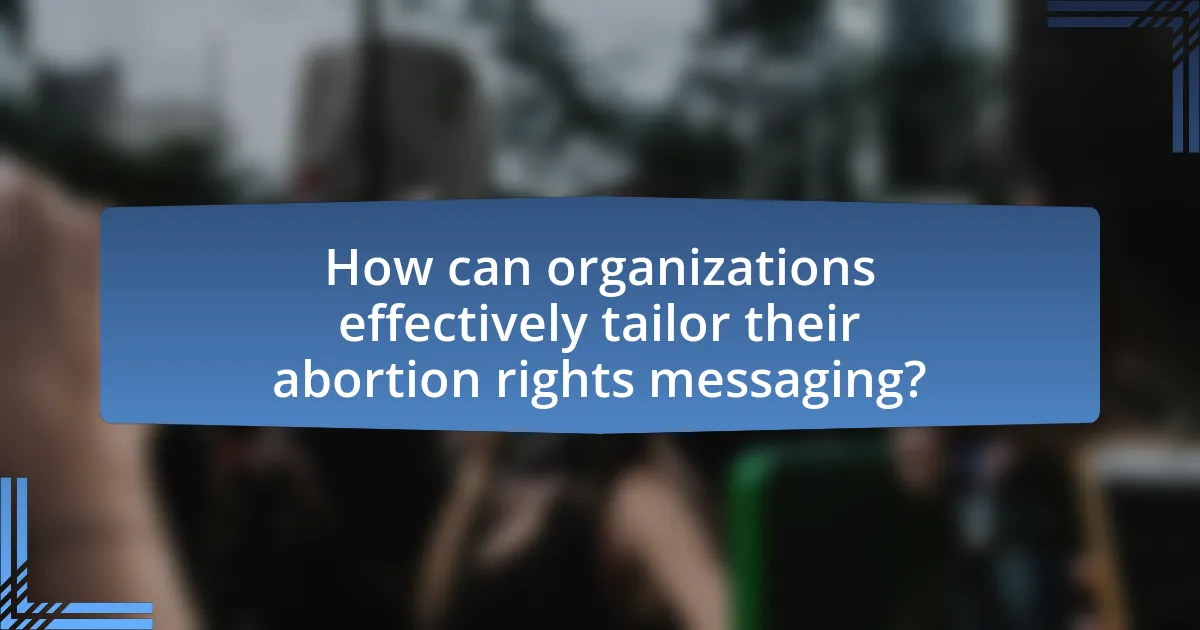
How can organizations effectively tailor their abortion rights messaging?
Organizations can effectively tailor their abortion rights messaging by understanding the specific cultural, social, and economic contexts of diverse communities. This approach involves conducting thorough research to identify the values, beliefs, and concerns of different demographic groups, which allows organizations to create targeted messages that resonate with those audiences. For instance, a study by the Guttmacher Institute highlights that messaging that incorporates local language and addresses community-specific issues, such as healthcare access and economic stability, significantly increases engagement and support for abortion rights. By utilizing data-driven insights and community feedback, organizations can craft compelling narratives that reflect the lived experiences of individuals, thereby fostering a more inclusive dialogue around abortion rights.
What strategies can be employed to engage diverse communities?
To engage diverse communities effectively, organizations should employ culturally relevant messaging, inclusive outreach methods, and community partnerships. Culturally relevant messaging ensures that communication resonates with the values and experiences of different groups, which can be supported by research indicating that tailored messaging increases engagement rates. Inclusive outreach methods, such as multilingual materials and accessible events, help to break down barriers to participation, as evidenced by studies showing that language accessibility significantly improves community involvement. Additionally, forming partnerships with local organizations that already serve diverse populations can enhance trust and credibility, leading to more effective engagement strategies.
How can organizations identify the unique needs of different communities?
Organizations can identify the unique needs of different communities by conducting comprehensive needs assessments that include surveys, focus groups, and community engagement initiatives. These methods allow organizations to gather qualitative and quantitative data directly from community members, ensuring that the insights reflect the specific cultural, social, and economic contexts of each group. For instance, a study by the Pew Research Center found that tailored messaging significantly improves engagement and understanding among diverse populations, highlighting the importance of addressing unique community needs in advocacy efforts.
What role does community involvement play in shaping effective messaging?
Community involvement is crucial in shaping effective messaging as it ensures that the communication resonates with the specific values, beliefs, and needs of the target audience. Engaging community members in the messaging process allows for the incorporation of local perspectives and cultural nuances, which enhances relatability and trust. For instance, research by the Public Religion Research Institute indicates that messages tailored to reflect community values significantly increase engagement and support for social issues, including abortion rights. This demonstrates that when communities actively participate in crafting messages, the resulting communication is more impactful and effective in mobilizing support.
What are the best practices for creating inclusive abortion rights campaigns?
The best practices for creating inclusive abortion rights campaigns include engaging diverse communities, using culturally relevant messaging, and ensuring representation in leadership roles. Engaging diverse communities involves actively listening to their specific needs and concerns, which can be achieved through focus groups and community forums. Culturally relevant messaging resonates more effectively with various demographics, as it reflects their values and experiences, thereby increasing the campaign’s impact. Additionally, ensuring representation in leadership roles within the campaign fosters trust and credibility, as individuals from diverse backgrounds can provide insights that enhance the campaign’s effectiveness. Research indicates that campaigns that prioritize inclusivity are more successful in mobilizing support and fostering understanding across different societal segments.
How can language and imagery be adapted for different audiences?
Language and imagery can be adapted for different audiences by considering cultural context, values, and communication preferences. For instance, using inclusive language and relatable imagery can resonate more effectively with marginalized communities, as demonstrated by research from the Guttmacher Institute, which highlights that tailored messaging increases engagement and understanding among diverse groups. Additionally, employing visuals that reflect the audience’s demographics and experiences fosters a sense of connection, making the message more impactful.
What methods can be used to evaluate the effectiveness of tailored messaging?
Methods to evaluate the effectiveness of tailored messaging include A/B testing, surveys, focus groups, and analytics. A/B testing allows for direct comparison of different message variations to determine which resonates more with the target audience. Surveys can gather quantitative and qualitative data on audience perceptions and reactions to the messaging. Focus groups provide in-depth insights through discussions that reveal emotional and cognitive responses to the messages. Analytics track engagement metrics, such as click-through rates and social media interactions, to assess the impact of the messaging on the intended audience. These methods collectively provide a comprehensive understanding of how well tailored messaging performs in reaching and influencing diverse communities regarding abortion rights.
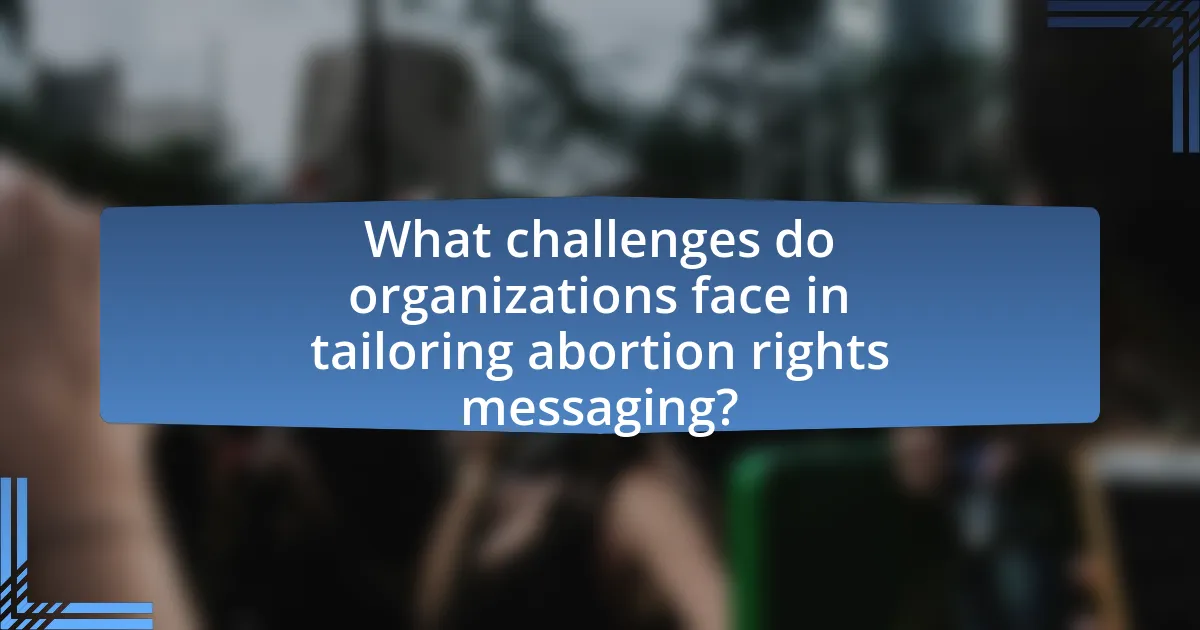
What challenges do organizations face in tailoring abortion rights messaging?
Organizations face significant challenges in tailoring abortion rights messaging due to the diverse beliefs and values within communities. These challenges include navigating varying cultural, religious, and political perspectives that influence individuals’ views on abortion. For instance, a 2021 Pew Research Center study found that 61% of Americans believe abortion should be legal in all or most cases, but this sentiment varies widely across demographic lines, such as age, race, and geographic location. Additionally, organizations must contend with misinformation and stigma surrounding abortion, which can hinder effective communication. Tailoring messages to resonate with specific audiences while remaining inclusive and respectful of differing opinions is crucial yet complex, as it requires a deep understanding of community dynamics and effective messaging strategies.
How can organizations overcome resistance to tailored messaging?
Organizations can overcome resistance to tailored messaging by actively engaging with the target audience to understand their unique perspectives and concerns. This engagement can include conducting surveys, focus groups, and community discussions, which provide valuable insights into the specific needs and preferences of diverse communities. Research indicates that organizations that invest in understanding their audience are more likely to create effective messaging that resonates, as evidenced by a study from the Pew Research Center, which found that tailored communication significantly increases audience receptivity. By fostering trust and demonstrating a commitment to addressing community-specific issues, organizations can effectively reduce resistance and enhance the impact of their tailored messaging.
What are common misconceptions about abortion that need addressing?
Common misconceptions about abortion include the belief that it is primarily used as a form of contraception, that it leads to severe mental health issues, and that it is a simple procedure without risks. Research indicates that most individuals seeking abortions do so after careful consideration and often due to financial, health, or personal circumstances, rather than as a casual choice. Additionally, studies, such as one published in the American Journal of Psychiatry, show that the majority of individuals do not experience long-term mental health problems following an abortion. Furthermore, while any medical procedure carries risks, the safety of abortion has improved significantly, with the World Health Organization stating that legal abortions performed by trained professionals are among the safest medical procedures. Addressing these misconceptions is crucial for informed discussions about abortion rights and access.
How can organizations build coalitions to support tailored messaging efforts?
Organizations can build coalitions to support tailored messaging efforts by identifying common goals and aligning their messaging strategies with the needs of diverse communities. This involves engaging stakeholders from various sectors, such as healthcare, advocacy, and community organizations, to create a unified approach that resonates with specific audiences. For instance, research shows that coalitions that include diverse voices are more effective in addressing the unique concerns of different demographic groups, leading to increased trust and engagement. By leveraging shared resources and expertise, organizations can enhance the impact of their tailored messaging initiatives, ultimately fostering a more inclusive dialogue around abortion rights.
What resources are available to assist in tailoring abortion rights messaging?
Resources available to assist in tailoring abortion rights messaging include organizations like Planned Parenthood, the Guttmacher Institute, and the Center for Reproductive Rights, which provide research, data, and messaging toolkits. These organizations offer insights into the specific needs and concerns of diverse communities, helping advocates craft effective and culturally relevant messages. For example, the Guttmacher Institute publishes reports that analyze public opinion on abortion across different demographics, which can inform targeted messaging strategies. Additionally, community-based organizations often share best practices and case studies that highlight successful messaging efforts tailored to specific populations.
What role do partnerships with local organizations play in effective messaging?
Partnerships with local organizations are crucial for effective messaging as they enhance credibility and ensure cultural relevance. By collaborating with these organizations, messaging can be tailored to resonate with specific community values and needs, thereby increasing engagement and understanding. Research indicates that campaigns that incorporate local insights and voices are more likely to succeed; for instance, a study by the Pew Research Center found that messages aligned with community perspectives significantly improve public reception and support for initiatives.
How can data and research inform tailored messaging strategies?
Data and research can inform tailored messaging strategies by providing insights into the specific needs, values, and preferences of diverse communities. For instance, demographic studies reveal that different cultural groups may prioritize various aspects of abortion rights, such as health care access or personal autonomy. Research conducted by the Guttmacher Institute indicates that messaging focused on personal stories and local impacts resonates more effectively with specific audiences, leading to increased engagement and support. By analyzing survey data and focus group feedback, organizations can refine their messaging to align with the unique perspectives of each community, ensuring that communications are relevant and impactful.
What practical tips can organizations implement for effective messaging?
Organizations can implement several practical tips for effective messaging by focusing on audience understanding, clarity, and cultural relevance. First, conducting thorough audience research helps organizations identify the specific needs, values, and concerns of diverse communities, ensuring that messages resonate. For instance, a study by the Pew Research Center highlights that tailored messaging significantly increases engagement and understanding among targeted demographics.
Second, using clear and straightforward language minimizes confusion and enhances message retention. Research from the Nielsen Norman Group indicates that users prefer concise and direct communication, which aids in comprehension.
Third, incorporating culturally relevant imagery and examples fosters a sense of connection and relatability. The American Psychological Association emphasizes that culturally tailored messages can improve the effectiveness of communication by aligning with the audience’s experiences and backgrounds.
Lastly, organizations should utilize multiple communication channels to reach diverse audiences effectively, as different groups may prefer different platforms. According to a report by the Digital Marketing Institute, multi-channel strategies can increase message visibility and engagement by up to 300%.
